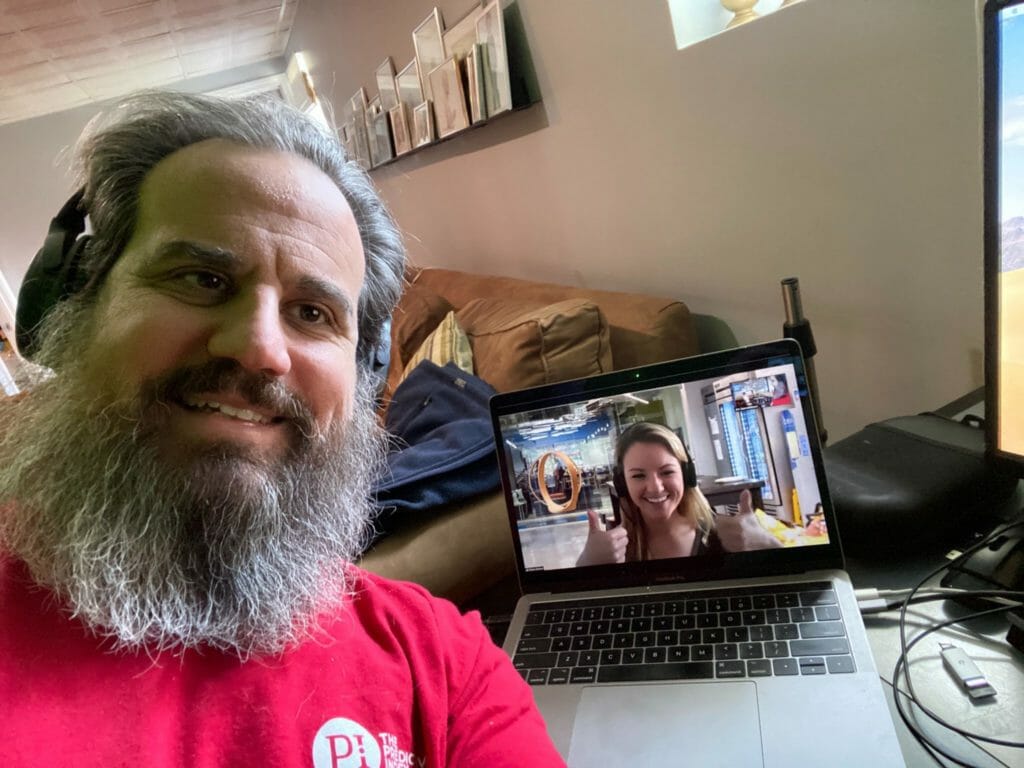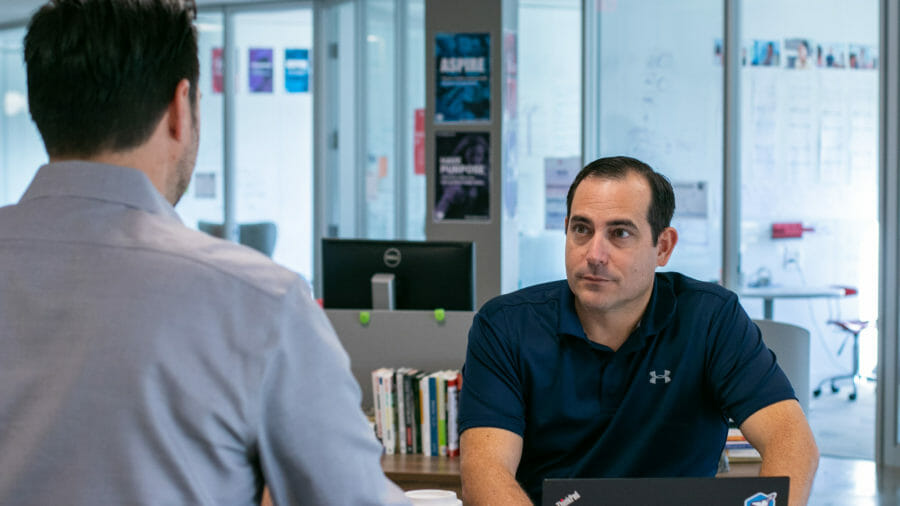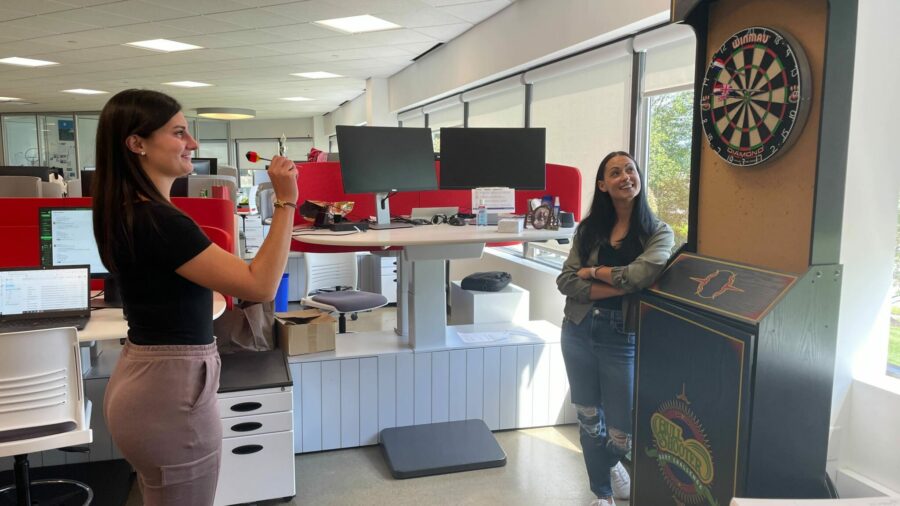You’ve probably heard the term “human energy crisis” by now. It’s out there, circulating in corporate circles and LinkedIn feeds, raising eyebrows and antennae among executives and employees alike.
And with good reason. As the phrase implies, we’ve got a real issue on our hands. Solving it is essential to helping our employees recharge.
But what, exactly, does a human energy crisis entail?
It’s a labor crisis. The people who do the work are bearing the brunt of the remote and hybrid work fallout—sunk commercial real estate costs notwithstanding—and as a result, they’re feeling uncertain, unfulfilled, and disconnected at an alarming rate.
Prolonged remote and hybrid work, combined with empty post-pandemic offices, is taking a significant psychological toll on many individuals. And those individuals—your people—are your greatest asset.
Here are the top 10 psychological impacts of prolonged stretches of remote, hybrid, and empty-office work:
1. Isolation and loneliness
This impact is much-discussed and well-known, but it persists. People are missing out on the social interactions and camaraderie that come with being in a shared physical workspace.
An entire generation of “digital natives” is being deprived of early-career opportunities to collaborate and create professional connections. The costs range from diminishing employee engagement to people simply having fewer friends.
There’s even an emerging sense of duty among more tenured professionals, many of whom feel the need to help these newer workers navigate the nuances of corporate life. These employees are at a real disadvantage when they so rarely come into contact with their colleagues.
2. Blurred work-life boundaries
Life creeping into work has been amazingly refreshing at times. In some ways, we know each other better as people, because we’ve seen each other’s kids pop into Zoom screens, or bonded over remote team cooking sessions.
But work creeping into life can have a huge negative impact.
It’s become almost a cliché to talk about how much time remote workers save by not commuting. There’s a flip side to that time saved: more time spent working. Studies are repeatedly finding that remote workers are starting earlier and staying online longer.
Is it really time saved if it’s time devoted almost entirely to work?

3. Zoom fatigue and screen overload
We’ve all felt it. Even if you went into the office as soon as social distancing mandates allowed, and haven’t returned home, you remember. Zoom fatigue was and is real.
The sample is still relatively small, but research consistently shows that prolonged exposure to video calls and screen time can cause exhaustion and mental strain. This particular type of fatigue might be new, but its impact is far-reaching. During the height of the pandemic, Zoom estimated it had 300 million daily participants.
And yet we continue to subject each other to it, even knowing the risks. It’s too easy to summon someone for a video call or set up back-to-back meetings. We need to figure out little ways to minimize this burden before it burns us all out.
4. Reduced sense of accomplishment
Some people thrive on the rush of a bustling office. They live for that celebratory high-five from a co-worker. These are usually your higher-extraversion employees, but they’re not the only ones feeling unfulfilled by the remote or hybrid workplace.
A lack of visible milestones and recognition can impact individuals’ motivation and self-esteem. Discretionary effort starts to wane, and we look for ways to offset the reassurance shortage.
Coming into a half-empty offense doesn’t satisfy our need for feeling appreciated. We have to be intentional about our recognition, using every tool at our disposal to give kudos or congratulate co-workers who just nailed that sale, published that piece, or completed that code.
5. Feeling disconnected from the organization
Workers today often feel detached from the company’s culture, values, and mission. People are increasingly craving feelings of being and belonging in their workplace.
You need to ensure people are not only clear on, but connected to, your mission and vision. In fact, your competitive advantage may depend on that connection. Increasingly, research indicates the younger cohort of professionals considers a company’s purpose a core factor in their job search.
If you can’t create that sense of purpose, you’ll have a tough time attracting top talent in our new world of work.
A personalized leadership approach for each team member.
PI’s behavioral insights help leaders inspire and coach each employee in a way they truly connect with.
6. Distractions and reduced focus
Yes, a bustling office can be a distraction, but homes have plenty of distractions themselves—many of them totally unrelated to work. The same goes for offices with dwindling headcounts.
In today’s world, a near-empty office can prompt a lot of unwanted fly-by conversations that too often aren’t efficient. Meetings happen for meeting’s sake—you can hardly blame the more extraverted people for seeking out socialization—and those fly-bys that once felt productive now labor on. As a result, we might feel strangely exhausted by our office visits, and end up working those longer hours.
We can combat this challenge with clear expectations around the hours people put in, as well as around our meetings and their agendas.
7. Decreased creativity and innovation
Interaction fuels creativity and innovation. And while your business model may dictate the work environment—and the number of opportunities people have to interact with each other—there are indications that remote work can stifle creativity.
One study of 60,000-some Microsoft employees found that, too often, businesses forced collaboration. Brainstorms fell flat because they lacked spontaneity and that organic impetus.
This is the stuff people miss the most. We must find ways to recreate these sorts of sessions, or our business strategies will inevitably stagnate.
8. Decreased accountability
Employees are more likely to stay on track when they know their actions are visible. Some companies have invested in productivity-tracking tools. And while most people don’t want to have a clock-in, clock-out system forced upon them, we can find middle ground that enhances accountability without compromising the flexibility remote work affords.
We can encourage accountability without sacrificing autonomy. Set clear expectations around attendance, response times, and communication channels. Let employees know that you don’t expect them to respond immediately to a late-day Slack message, but that you do need them to respond, and that everyone is expected to be where they need to be, when they need to be there.

9. Limited networking
Offices provide a platform for networking, exposure and friendship. We can’t overlook this fact. People need people.
Again, the effects are amplified here for the youngest members of the workforce, many of whom have known nothing else. If you graduated from college and started your first job in 2020 or 2021, you might be missing out not just on happy hours and HR sessions, but also on chances to advance your career and go beyond your immediate organization.
There are ways to network from home, but most of them don’t compare to the intangible impacts of, say, attending conferences or showing up for industry meet-and-greets.
10. Career progression concerns
This is perhaps the most pressing concern for people managers and aspiring leaders. How can we create the next generation of innovators if we aren’t focused on their development?
The lack of face-to-face interactions with supervisors and colleagues can lead to concerns about being overlooked for promotions or important projects. No longer can people exert influence as easily.
Professional development in a remote or hybrid workplace requires clear intent. Create templates and toolkits, consult skills matrices, and reiterate that you’re invested in your people, long-term, regardless of whether they stay or go. An emphasis on employee development will always pay off.
A collective cause
It is clear today’s work is taking a psychological toll—and we’re probably just scratching the surface of its impact. The good news is that companies can address, if not completely solve, each of these issues. And by addressing them with intention and transparency, these factors can be taken off the table as major stressors.
The hardest part is determining who is suffering from what. An employee experience pulse or annual survey can help you diagnose (and solve for) disengagement before it leads to attrition.
But if you had to do one thing that helps all of this more than anything else, do this: Make an investment in your “shared fate.” When your employees feel really tied into the big, hairy, audacious “why” behind their work, that is when they help you find out how to help them.


